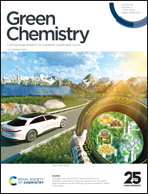Semiconductor biohybrids for enhanced bifunctional wastewater sulfur and heavy metal removal†
Abstract
The desulfurization technology is of great significance in wastewater treatment, although heavy metal ions are often introduced. Yet it remains a serious issue to remove sulfur and heavy metals simultaneously from waste water. Herein, we reported an autophotosensitive biohybrid system consisting of non-phototrophic Halothiobacillus neapolitanus (H. neapolitanus) and cadmium sulfide nanoparticles (CdS NPs) for the removal of sulfide and heavy metals simultaneously without organic nutrients and anaerobic conditions. The photogenerated electrons could be efficiently transferred from biosynthesized CdS to bacteria in the CdS–H. neapolitanus biohybrid system with light irradiation, due to the membrane-bound electron acceptors (e.g., quinols and C-type cytochrome) with a series of electron transport chains. Compared to H. neapolitanus, the biosynthesized CdS as an armor could protect the growth activity up to 146% at higher Cd concentrations and enhance the desulfurization efficiency up to 129%. Therefore, this biohybrid system provides a potential strategy for in situ wastewater denitrification, desulfurization and heavy metal removal applications.



 Please wait while we load your content...
Please wait while we load your content...